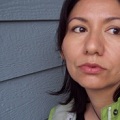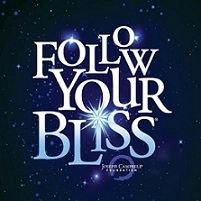

I celebrate the holiday of
Thanksgiving.
Thanksgiving to me has never
been about Pilgrims. When I was six, my mother, a woman of the Dineh
nation, told my sister and me not to sing "Land of the Pilgrim's
pride" in "America the Beautiful." Our people, she said,
had been here much longer and taken much better care of the land. We
were to sing "Land of the Indian's pride" instead.
I was proud to sing the new
lyrics in school, but I sang softly. It was enough for me to know the
difference. At six, I felt I had learned something very important. As a
child of a Native American family, you are part of a very select group
of survivors, and I learned that my family possessed some
"inside" knowledge of what really happened when those poor,
tired masses came to our homes.
When the Pilgrims came to
Plymouth Rock, they were poor and hungry -- half of them died within a
few months from disease and hunger. When Squanto, a Wampanoag man, found
them, they were in a pitiful state. He spoke English, having traveled to
Europe, and took pity on them. Their English crops had failed. The
native people fed them through the winter and taught them how to grow
their food.
These were not merely
"friendly Indians." They had already experienced European
slave traders raiding their villages for a hundred years or so, and they
were wary -- but it was their way to give freely to those who had
nothing. Among many of our peoples, showing that you can give without
holding back is the way to earn respect. Among the Dakota, my father's
people, they say, when asked to give, "Are we not Dakota and
alive?" It was believed that by giving there would be enough for
all -- the exact opposite of the system we live in now, which is based
on selling, not giving.
To the Pilgrims, and most
English and European peoples, the Wampanoags were heathens, and of the
Devil. They saw Squanto not as an equal but as an instrument of their
God to help his chosen people, themselves.
Since that initial sharing,
Native American food has spread around the world. Nearly 70 percent of
all crops grown today were originally cultivated by Native American
peoples. I sometimes wonder what they ate in Europe before they met us.
Spaghetti without tomatoes? Meat and potatoes without potatoes? And at
the "first Thanksgiving" the Wampanoags provided most of the
food -- and signed a treaty granting Pilgrims the right to the land at
Plymouth, the real reason for the first Thanksgiving.
What did the Europeans give in
return? Within 20 years European disease and treachery had decimated the
Wampanoags. Most diseases then came from animals that Europeans had
domesticated. Cowpox from cows led to smallpox, one of the great killers
of our people, spread through gifts of blankets used by infected
Europeans. Some estimate that diseases accounted for a death toll
reaching 90 percent in some Native American communities. By 1623, Mather
the elder, a Pilgrim leader, was giving thanks to his God for destroying
the heathen savages to make way "for a better growth," meaning
his people.
In stories told by the Dakota
people, an evil person always keeps his or her heart in a secret place
separate from the body. The hero must find that secret place and destroy
the heart in order to stop the evil.
I see, in the "First
Thanksgiving" story, a hidden Pilgrim heart. The story of that
heart is the real tale than needs to be told. What did it hold? Bigotry,
hatred, greed, self-righteousness? We have seen the evil that it caused
in the 350 years since. Genocide, environmental devastation, poverty,
world wars, racism.
Where is the hero who will
destroy that heart of evil? I believe it must be each of us. Indeed,
when I give thanks this Thursday and I cook my native food, I will be
thinking of this hidden heart and how my ancestors survived the evil it
caused.
Because if we can survive, with
our ability to share and to give intact, then the evil and the good will
that met that Thanksgiving day in the land of the Wampanoag will have
come full circle.
And the healing can begin. This may surprise those people
who wonder what Native Americans think of this official U.S. celebration
of the survival of early arrivals in a European invasion that culminated
in the death of 10 to 30 million native people.
This may surprise those people
who wonder what Native Americans think of this official U.S. celebration
of the survival of early arrivals in a European invasion that culminated
in the death of 10 to 30 million native people.


Jacqueline Keeler, a member of the Dineh Nation and the Yankton Dakota Sioux works with the American Indian Child Resource Center in Oakland, California.
Her work has appeared in Winds of Change, an American Indian journal.
Dineh People: the USMC Code Talkers of World War II (Dr. Sam Billison)
by Sister Mary Josť Hobday, OSF
Sister Mary Josť Hobday, OSF, was a Seneca elder, storyteller, author, professor, Franciscan Sister, and dear friend of A Network for Grateful Living.Thanksgiving. It has different meanings for different people. For some, it is an extended holiday weekend. For others, a day of thanks that may or may not include church. For still others, it's a day to gather the family around a big meal, with vague notions of Indians and Pilgrims in the background.
For Native Americans, it may be a sad day of remembering what they lost because of the appearance of another culture with different values and customs. Among younger tribal members, it is often a day of protesting and calling attention to grievances.
For me, the meaning of thanksgiving has been enriched by my Native American background, especially by the traditions of the Seneca Iroquois Tribe, which are extensive and thought provoking. This tribe has one celebration of giving thanks, for instance, that lasts four full days. It has a formal order consisting of storytelling, teachings, silence, singing, drumming, chanting, rest, the serving of special foods (including the sacred berry of the tribe, the strawberry), and remembering all of the things for which to be thankful.
To help remember, the ritual has 16 special chants of thanks. They are for people, the earth, plants, water, trees, animals, birds, the "sisters," (special powers that help people take care of themselves and look after each other), the wind, thunderors (powers that bring rain), the sun, the moon, the stars, the Four Beings (powers that bring enlightenment and strength), Handsome Lake (a member of the tribe who was particularly effective in spreading Christian values), and, finally, the Creator.
In this ritual, the chanting of the story of thanksgiving night begin like this: "Now the people have gathered to give thanks. In the early times, the Sky Dwellers (beings in Native American origin stories who came to earth and helped Populatcit) told us we must move about the earth with love. They said the first thing we must do when we meet one another is be thankful for each other. Above all, we must relate to the earth as our mother, who supports all, even our very feet." It continues litany-like in this fashion.
I like this ritual because of its world focus, and that's one reason I think it's worth passing on as we approach our great national holiday, Thanksgiving. Often we take all that we have for granted.
Or, we think that we have earned everything we have. We fail to see, as we would if we were really observant, that the things we have - especially the important things - are indeed gifts that we have received from the earth, from each other, and, when all is said and done, from God.
Or, if we are thankful to God, we don't really appreciate the fact that God has given us all the gifts we have, including life itself, through creation. I'm afraid we still think of the Creator as completely separate from creation, and, by doing that, we perpetuate the old dichotomies that have plagued us in the past.
As you can see from this Seneca Iroquois ritual of thanksgiving, Native American people have less difficulty with this. Somehow, they were able to keep their focus on this world longer than many of us Christians, and they still were able to relate it to the Creator. Note this, for example, in the 16 thanksgiving chants of this ritual - the first 15 are about creation and then comes the Creator.
The point here is not necessarily to duplicate this Native American ritual of thanksgiving - can you imagine yourself giving thanks for four solid days? - but to appreciate the profound sense of thanksgiving Native Americans have. Native peoples, I think, have avoided the dichotomy between the spiritual and the material. In this way, Native Americans can enrich the celebration of this greatest American feast - Thanksgiving - and our more important Christian celebration of thanks - the Eucharist.
The Seneca are a group of indigenous people native to North America. They were the nation located farthest to the west within the Six Nations or Iroquois League in New York before the American Revolution. It was the French priest missionaries who first called the Haudenosaunee by the name of Iroquois. Ironically, there is evidence that America's Founding Fathers, after the Revolution, turned to the Iroquois for inspiration when forging our own Constitution. The Iroquois had sided against us, and had known George Washington as an arch enemy. But their own confederation had actually been surprisingly advanced. It was known as Gayanashagowa or the Great Law of Peace. See George Washington Town Destroyer

Religion is for people who're afraid of going to hell.
Spirituality is for those who've already been there.
[ Vine Deloria ]
Site maintained by
Robert Shepherd
photograph